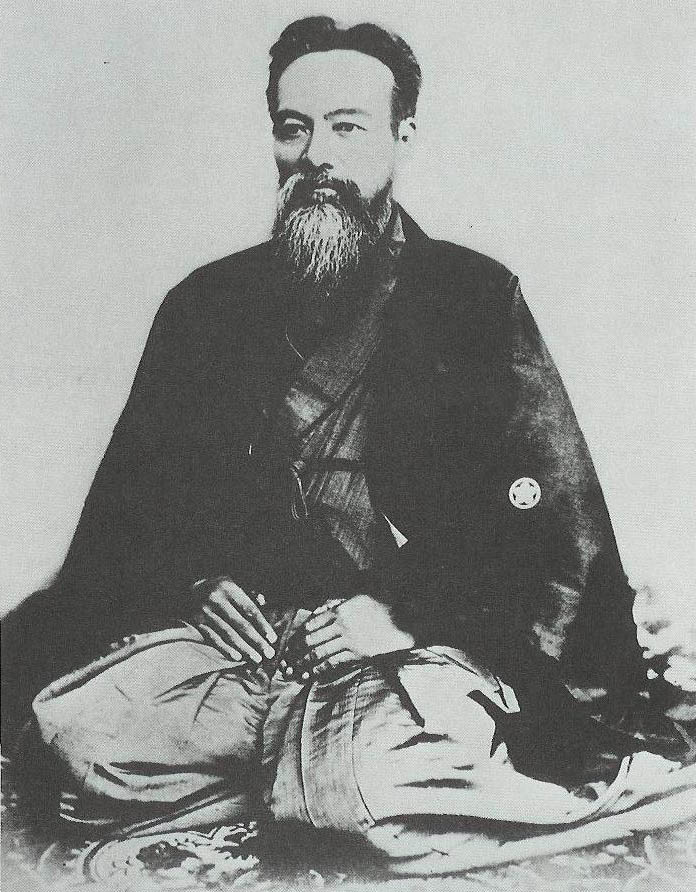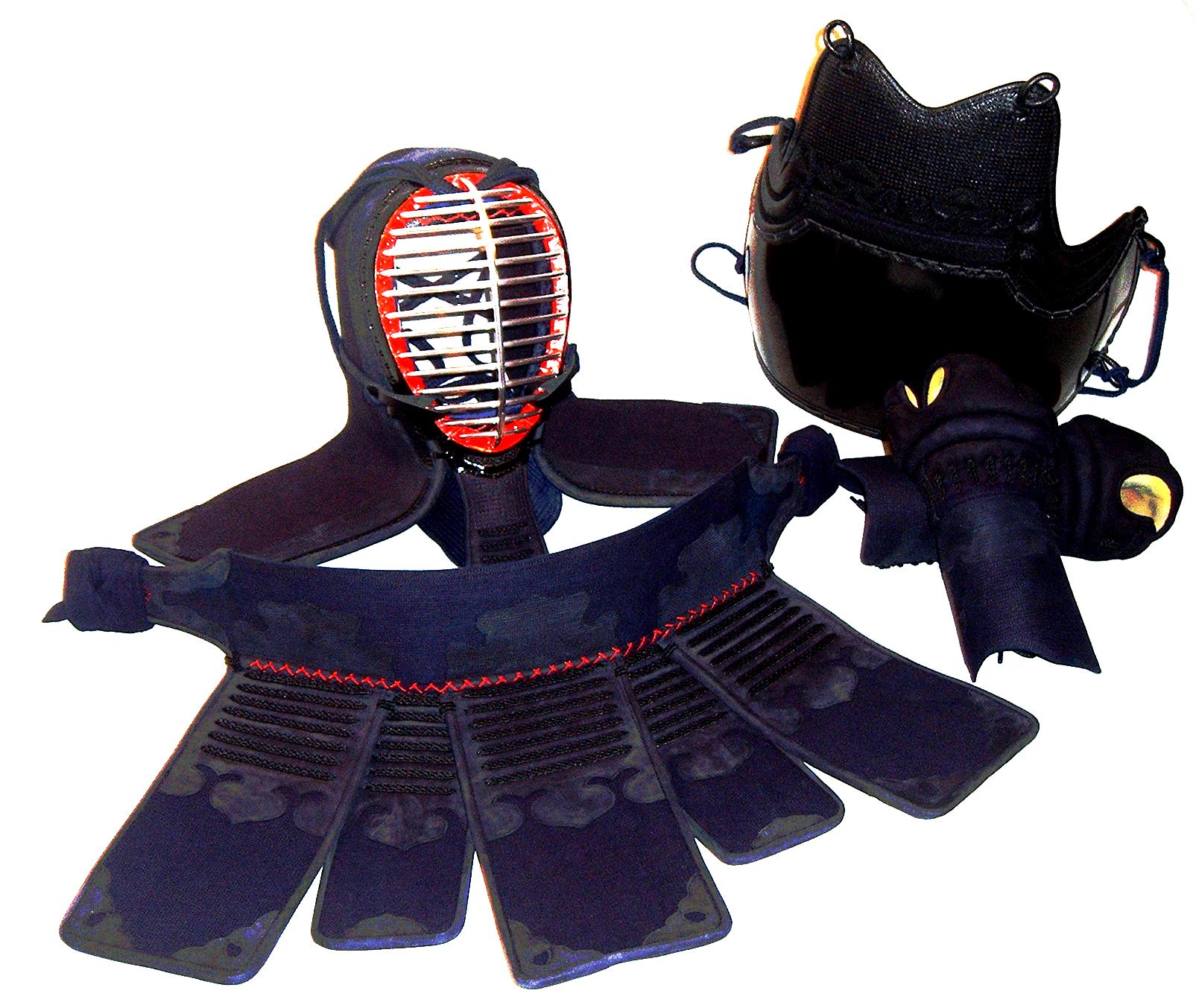|
Hokushin Ittō-ryū
is a that was founded in the late Edo period by . He was one of the last masters who was called a . Curriculum and Characteristics The curriculum of this (martial arts style) contains mainly , and , but the main weapons used are the long and short swords (katana and ). Hokushin Ittō-ryū is a very intense duelling style which focuses on simple and fast techniques where no unnecessary movements are made. Controlling the enemy's centre line with the (cutting down the opponent's sword, a signature technique and principle of Ittō-ryū) and dominating them with extremely fast (sword thrusting techniques) are the signature techniques of this . The principles of this style are that a perfect technique should contain defence and offence in one action. Characteristic of the training is the use of (heavily padded gloves) like in its ancestor styles Ono-ha Ittō-ryū and Nakanishi-ha Ittō-ryū, which are used in several (two person practice). This kind of training became mor ... [...More Info...] [...Related Items...] OR: [Wikipedia] [Google] [Baidu] |
Battōjutsu
is an old term for iaijutsu (居合術). ''Battōjutsu'' is often used interchangeably with the terms ''iaijutsu'' and ''battō'' (抜刀).Armstrong, Hunter B. (1995) "The Koryu Bujutsu Experience" in ''Koryu Bujutsu: Classical Warrior Traditions of Japan'' (ed. Diane Skoss). Koryu Books. Page 32. Generally, ''battōjutsu'' is practiced as a part of a classical '' ryū'' and is closely integrated with the tradition of ''kenjutsu''. It is practised with a live blade (''katana''), often simply as solo kata. The training is for combative effectiveness, through factors such as distancing, timing and targeting. As such, ''battōjutsu'' is not intended for sport-like kendo. List of schools Koryu school: * Shinmei Muso Ryu Battōjutsu (神明夢想流 抜刀術), founded by Hayashizaki Jinsuke (Minamoto no) Shigenobu(林崎甚助(源)重信) (c. 1542–1621) * Sekiguchi Ryu Battōjutsu (or Iai) (関口流抜刀術), founded by Sekiguchi Ujinari (関口氏業) (1636–1716) Gendai s ... [...More Info...] [...Related Items...] OR: [Wikipedia] [Google] [Baidu] |
Tōdō Heisuke
was a samurai of Japan's late Edo period who served as the eighth unit captain of the Shinsengumi. His full name was ''Tōdō Heisuke Fujiwara no Yoshitora''. Background Tōdō was from Edo, Musashi Province (now Tokyo). Very little is known about his origin. Although he was said to be an illegitimate child of Tōdō Takayuki, the 11th generation lord of the Tsu domain, this is highly debatable. However, one argument some use in favor of this theory is the fact that he possessed a sword made by ''Kazusa no suke'' Kaneshige, who was a swordmaker under the patronage of the Tsu domain; and that such a sword would be difficult for a mere rōnin to obtain, even by heritage. Another point that suggests possible Tsu domain heritage is his formal given name , , which shares a character in common with the name of the first Tōdō lord of Tsu, . Tōdō was a practitioner of the ''Hokushin Ittō-ryū'', trained at Chiba Shusaku Narimasa's dojo. However, according to some sources, he was ... [...More Info...] [...Related Items...] OR: [Wikipedia] [Google] [Baidu] |
Yamanami Keisuke
was a Japanese samurai. He was the General Commander (総長, Sōchō) of the Shinsengumi, a special police force in Kyoto during the late Edo period. Background Though the details of his origin are unclear, he was thought to be the son of a kenjutsu instructor originated from the Sendai domain. Yamanami was trained under Chiba Shusaku Narimasa, the founder of the '' Hokushin Itto-ryu'', and attained ''Menkyo Kaiden'' (''license of total transmission'') sometime before 1860. In 1860 after Yamanami was defeated by Kondō Isami in a match, he was enrolled at the '' Tennen Rishin-ryūs Shieikan dojo in Edo (which was run by Kondō from 1861.) Yamanami was particularly educated in literary and military arts, with a gentle personality and a kind heart. He was very much admired by the Head Instructor (Jukutou) at the Shieikan, Okita Sōjirō (the later Okita Sōji), who called him a big brother. In 1863, Yamanami, Kondo, and other members of the Shieikan joined the Rōshigumi ... [...More Info...] [...Related Items...] OR: [Wikipedia] [Google] [Baidu] |
Chiba Sana
Chiba may refer to: Places China * (), town in Jianli County, Jingzhou, Hubei Japan * Chiba (city), capital of Chiba Prefecture ** Chiba Station, a train station * Chiba Prefecture, a sub-national jurisdiction in the Greater Tokyo Area on the eastern coast of Honshū * Port of Chiba, Chiba Prefecture People * Chiba (musician), American rapper * Chiba (surname) Other uses * Chiba (instrument), a Chinese woodwind * Chiba, slang for ''cannabis'' * Chiba Thermal Power Station, Japan * Chiba University, a national university in the city of Chiba See also *Chica (other) *Chika (other) Chika may refer to: People * Chika (Igbo given name) * Chika (Japanese given name) * Chika (general name) * Chika (footballer) (born 1979), Brazilian defender * Chika (rapper), Jane Chika Oranika, American rapper Other uses * Chika (software), a J ... * Chib (other) * Chiva {{disambiguation, geo ... [...More Info...] [...Related Items...] OR: [Wikipedia] [Google] [Baidu] |
Yamaoka Tesshū
, also known as Ono Tetsutarō or Yamaoka Tetsutarō, was a famous samurai of the Bakumatsu period, who played an important role in the Meiji Restoration. He is also noted as the founder of the '' Itto Shoden Muto-ryu'' school of swordsmanship. Along with Katsu Kaishū and Takahashi Deishū they were called “The Three Boats of the Bakumatsu (幕末の三舟)”. Early life Yamaoka was born in Edo (present-day Tokyo) as Ono Tetsutaro, where his father was a retainer of the Tokugawa shogunate and his mother was the daughter of a Shinto priest from Kashima Shrine. Yamaoka practiced swordsmanship from the age of nine, starting in the '' Jikishinkage-ryū'' tradition. After that he learned ''Hokushin Ittō-ryū'' from Inoue Hachirō, who was asked by Yamaoka Tesshū's father to teach his son. Later his family moved to Takayama where he began the '' Nakanishi-ha Ittō-ryū'' style of fencing. When he was seventeen, he returned to Edo and joined the government's ''Kobukan'' Milit ... [...More Info...] [...Related Items...] OR: [Wikipedia] [Google] [Baidu] |
Shinsengumi
The was a small secret police organization, elite group of swordsmen that was organized by commoners and low rank samurai, commissioned by the (military government) during Japan's Bakumatsu period (late Tokugawa shogunate) in 1863. It was active until 1869. Stephane Lun (2021) "A Guide on Shinsengumi: the background and management." indle paperwhite versionRetrieved from amazon.com It was founded to protect the shogunate representatives in Kyoto at a time when a controversial imperial edict to exclude foreign trade from Japan had been made and the Chōshū clan had been forced from the imperial court. They gained considerable fame in the Ikedaya incident and the August 18 coup events, among others. The men were drawn from the sword schools of Edo. History Japan's forced opening to the west in 1854, which required it to open its shores for trade or face military conflict, exacerbated internal political instability. One long-standing line of political opinion was (mea ... [...More Info...] [...Related Items...] OR: [Wikipedia] [Google] [Baidu] |
Sakamoto Ryōma
was a Japanese ''samurai'', a '' shishi'' and influential figure of the ''Bakumatsu,'' and establishment of the Empire of Japan in the late Edo period. Sakamoto was a low-ranking ''samurai'' from the Tosa Domain on Shikoku and became an active opponent of the Tokugawa Shogunate after the end of Japan's ''sakoku'' isolationist policy. Under the alias , he worked against the Bakufu, the government of the Tokugawa shogunate, and was often hunted by their supporters and the ''Shinsengumi''. Sakamoto advocated for democracy, Japanese nationalism, return of power to the Imperial Court, abolition of feudalism, and moderate modernization and industrialization of Japan. Sakamoto successfully negotiated the Satchō Alliance between the powerful rival Chōshū and Satsuma domains and united them against the Bakufu. Sakamoto was assassinated in December 1867 with his companion Nakaoka Shintarō, shortly before the Boshin War and the Meiji Restoration. Early life Sakamoto Ryōma was ... [...More Info...] [...Related Items...] OR: [Wikipedia] [Google] [Baidu] |
Takano Sasaburo
Takano (written: 高野) is a Japanese surname. Notable people with the surname include: * Ai Takano, Japanese singer *Aya Takano, Japanese artist and writer *Aya Takano (swimmer), Japanese athlete *Takano Chōei, scholar of the late Edo period * Takano Fusataro, Japanese labor activist * Genshin Takano, Governor of Hiroshima Prefecture from June 10 to October 11, 1945. *George Takano, professional wrestler * Hajime Takano, Japanese journalist *Hassei Takano, Japanese actor *, Japanese shogi player * Hiroshi Takano, Japanese musician *Isoroku Takano, birth name of Isoroku Yamamoto, Japanese naval officer * Takano Iwasaburo, Japanese social statistician *Kazuaki Takano, Japanese writer of crime fiction *Kikuo Takano, Japanese poet and mathematician * Mari Takano, Japanese musician *Mark Takano, U.S. politician * Takano no Niigasa, 8th-century concubine *, Japanese shogi player * Shiho Takano, Japanese actress * Shunji Takano, Japanese wrestler * Susumu Takano, Japanese track athlete ... [...More Info...] [...Related Items...] OR: [Wikipedia] [Google] [Baidu] |
Shinai
A is a Japanese sword typically made of bamboo used for practice and competition in '' kendō''. ''Shinai'' are also used in other martial arts, but may be styled differently from ''kendō shinai'', and represented with different characters. The light, soft wood used in a ''shinai'' distinguishes it from other wooden swords such as a '' bokuto (木刀)'', usually called a bokken (木剣) outside Japan, which is generally made of heavier, sturdier wood. History The earliest use of a bamboo weapon to train with instead of a sword is credited to Kamiizumi Nobutsuna (1508–1572?) of the Shinkage-ryū. The modern ''shinai'', with four slats of bamboo, is generally credited to Nakanishi Chuzo Tsugutate (died 1801) of Nakanishi-ha Ittō-ryū. The ''shinai'' was developed in an effort to reduce the number of practitioners being seriously injured during practice, making a practice weapon that was less dangerous than , the hard wooden swords they were previously using. This is a ... [...More Info...] [...Related Items...] OR: [Wikipedia] [Google] [Baidu] |
Bōgu
, properly called , is training armour used primarily in the Japanese martial arts, Japanese martial art of kendo,Uchida, M. (2005)Kendo Bogu (Protective Equipment)(October 2005). Retrieved on 12 May 2010. (2002). Retrieved on 12 May 2010. with variants used for jūkendō, tankendo, and naginatajutsu, naginata. History During the Edo period (1603-1868) the use of real swords for training purposes was discouraged due to injuries, with wooden practice swords in the form of and were often used instead. To further reduce injuries, practice armour based on traditional samurai armor was developed, with this practice armour being the basis for the modern .Description and use The word consists of two parts: , meaning "protect" or "defend," and , meaning "equipment" or "tool."[...More Info...] [...Related Items...] OR: [Wikipedia] [Google] [Baidu] |
Gekiken
is a modern Japanese martial art, descended from kenjutsu (one of the old Japanese martial arts, swordsmanship), that uses bamboo swords (shinai) as well as protective armor (bōgu). It began as samurai warriors' customary swordsmanship exercises, and today, it is widely practiced within Japan and has spread to many other nations across the world. History Swordsmen in Japan established schools of ''kenjutsu'' (the ancestor of kendo). These continued for centuries and form the basis of kendo practice today.. Formal kendo exercises known as ''kata'' were developed several centuries ago as ''kenjutsu'' practice for warriors. They are still studied today, in a modified form. The introduction of bamboo practice swords and armor to sword training is attributed to during the Shotoku Era (1711–1715). Naganuma developed the use of this armor and established a training method using bamboo swords. , third son of Naganuma and the eighth headmaster of the Kashima Shinden Jikishin ... [...More Info...] [...Related Items...] OR: [Wikipedia] [Google] [Baidu] |





